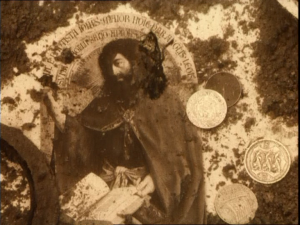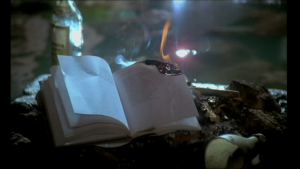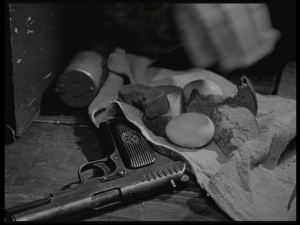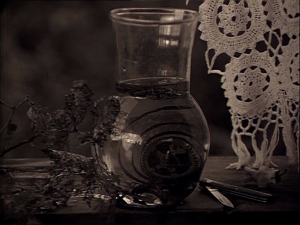
In Andrei Tarkovsky’s films, the objects are as important as the characters. In each of his shots, he pays as intransigent attention to them as he does to everything else. One may recognize therein an echo of old still lifes, but that does not suffice to account for the main function they perform in a process where their materiality serves to highlight the realm of the invisible. Philippe Bettinelli attempts here to rediscover the sources of these images of things by activating the notion of the living still life—an indispensable notion for our seminar.
Laurence Bertrand Dorléac
'Immersing the Most Familiar Things in an Irrational Atmosphere':
Objects in the Films of Andrei Tarkovsky
Philippe Bettinelli
“Starting with Solaris, and then in Mirror, and in Stalker there are the same objects, always the same. Certain bottles, certain old books, mirrors, various little objects on shelves or on windowsills. Only that which I would like to have in my home has the right to find itself in a shot of one of my films. If the objects are not to my liking, I simply cannot allow myself to leave them in the film, . . . . And nevertheless, from this point of view, I eliminate and annul, with maximum intransigence, any thing that I do not like from the shot.”[ref]“A Conversation between Andrei Tarkovsky and Tonino Guerra (1979),” originally published in Panorama, 676 (April 3, 1979): pp. 160-61, 164, 166, 169-70, and now available at: http://people.ucalgary.ca/~tstronds/nostalghia.com/TheTopics/Tarkovsky_Guerra-1979.html[/ref]

Fig. 1. Still from Stalker (1979)
Andrei Tarkovsky pays particular attention to the materiality of his films, to the constitution of a physical context within which his characters move. This physical context takes form through the positioning of objects chosen with great care and with a special concern for the material effects of the surfaces—floors, walls—that surround them. His films thereby take on a resolutely haptic dimension. Tarkovsky’s cinema, is, however, overtly religious, sometimes described as cinema of the invisible, and it seems in many of its aspects to aim at a form of immateriality more than a description of the real world and of the quite tangible things that populate that world.
These things can sometimes take on a symbolic function, as Jacques Aumont has emphasized in his analysis of a scene from Stalker. In a long vertical traveling shot, this scene shows a sequence of objects abandoned in the Zone that borders on the kind of “montage of objects” found in Dutch painting.[ref]Jacques Aumont, Matière d’image (Paris: Images modernes, 2005).[/ref] Showing weapons, pages of a calendar, syringes, and coins, as well as a reproduction of the John the Baptist from the Gand Altarpiece, this sequence of objects may be said to take on, quite specifically, the meaning of a vanity. As for the reproduction of Van Eyck’s work, qua damaged image of a witness of God reduced to the rank of an object and covered with sludge and refuse, it may be said to have certain similarities to that of the Stalker himself, wracked at the time with doubt. The example of Stalker is far from a hapax in Tarkovsky’s work: other examples of “montages of objects” echoing the narrative may be identified, beginning with a shot from Nostalghia. While the main character, a Russian musicologist suffering from his exile in Italy, wanders drunkenly amid some ruins and falls asleep, the camera lingers over a vodka bottle and a book on fire—a collection of poems by Arseny Tarkovsky translated into Italian, which this character had been offered as a gift at the start of the film, only to turn it down, arguing the untranslatableness of poetry. This shot echoes another, similar one, at the start of the film, which shows a Bible and a bottle of water: it echoes, in an almost literal way, the main character’s own disarray, his difficult connection to Italy, and the piercingly intense nostalgia he feels for Russia.

Fig. 2. Still from Nostalghia (1983)
By the way that they are composed, quite a number of shots, like that one, quite clearly come close to the pictorial genre of the still life, though it would be impossible to see therein the quotation of a specific work. The first of these in Tarkovsky’s work is perhaps to be found in a shot from Ivan’s Childhood, wherein the characters prepare some food before going out on a mission. The characters bring into the frame a number of objects, as if they were in the process of composing a still life. Although Tarkovsky, aligning himself with statements made by Robert Bresson on the purity of the cinematographic medium, has rejected on several occasions the idea of painting having a direct influence on cinema, these shots seem to testify to a diffuse form of pictoriality that is expressed even down to Tarkovsky’s penchant for windowsills, on which he likes to place objects in precise fashion, such detailing being commonplace in painting, with The Arnolfini Portrait certainly being the most illustrious example. On account of this juxtaposition of objects in frieze form on a neutral background, such compositions sometimes are reminiscent, as in a shot from Mirror, of bodegón painting: presenting an apple core, a wilted plant, and a timepiece mechanism, it rests on objects Charles Sterling has presented as symbolic of a passing of time in Dutch still lifes[ref]Charles Sterling, Still Life Painting: From Antiquity to the Twentieth Century (New York: Harper & Row, 1981), p. 72.[/ref]—which, in a shot that shows us a childhood memory, takes on its full meaning.

Fig. 3. Still from Ivan’s Childhood (1962)
This diffuse pictoriality, this subterranean presence of painting in some shots that seem to be working out, with this medium, some distant, and perhaps partially irrational, kinships, serves to develop a kind of fascination for what nevertheless are some eminently everyday objects, often ones integrated into the movie set in a completely coherent diegetic way. These as-if bracketed or suspended things then take on a quality of special presence, which could be said to help make them be thought of as something a bit more than objects, or a bit other than objects, so much does the director’s arrangement of them seem to bring them out of the realm of everyday experience to which they are generally confined—just as the Spanish painters had, to quote Sterling once again, “the power of immersing the most familiar things in an irrational atmosphere.”[ref]Ibid., p. 94.[/ref]
Through the layout of these objects, Tarkovsky seems to be seeking to give concrete form to a command drawn from the film maker Bresson’s Notes on Cinematography: “Make the objects look like they want to be there.”[ref]Robert Bresson, Notes on Cinematography (1975), trans. Jonathan Griffin (New York: Urizen Books, n.d.), p. 56.[/ref] And quite paradoxically, this effort makes them seem extremely familiar—they seem to be where they ought to be—and at the same time extremely strange—this decision may be said to come from them, and they would then no longer quite be things. Tarkovsky, who has often said that man was no longer capable of picking up the traces of God in daily life, seems to be leaving some clues of a realm beyond things and letting one glimpse the discreet presence of a form of the invisible.

Fig. 4. Still from Mirror (1975)
Through the quality of special presence Tarkovsky confers upon them, the things that populate his films may just remind one of Surrealism’s taste for objects. While from his first film onward Tarkovsky had been linked to Surrealism,[ref]In the first place, by Jean Paul Sartre; see his “Discussion on the Criticism of Ivan’s Childhood,” trans. Madan Gopal Singh, available at: http://people.ucalgary.ca/~tstronds/nostalghia.com/TheTopics/Sartre.html[/ref] he would go on to reject this label and, moreover, evince on several occasions his hostility to all of Modern Art, which he reproached in particular for its lack of spirituality. In contradiction to these declarations of principle, in Tarkovsky’s diary one finds numerous indications of an at least relative taste for Modern Art,[ref]Andreï Tarkovski, Journal 1970-1986 (Paris: Cahiers du Cinéma, 1993), pp.284-85.[/ref] and one also knows from his art director on Solaris that Tarkovsky appreciated the work of several modern artists, including René Magritte and Salvador Dalí, who established “a sort of dialogue with the old masters.”[ref]Mikhail Romadin, “Film and Painting,” in Nathan Dunne, ed., Tarkovsky (London: Black Dog, 2008), p. 388.[/ref]
It is, however, not the literally Surrealist Dalí who might have influenced Tarkovsky, but the postwar Dalí, marked by a “Nuclear Mysticism,” the one who, according to Robert Descharnes, performed the “threefold synthesis of classicism, the spiritual and concern with the nuclear age,”[ref]Robert Descharnes and Gilles Néret, Salvador Dalí 1904-1989, trans. Michael Hulse (London: Taschen, 1997), p. 417.[/ref] a phrase that could just as well describe Tarkovsky’s films. More than in some exact quotations, this proximity may be felt in his reprise of one of Dalí’s concepts, that of the “living still life.”
In his “nuclear mysticism” period, Dalí did indeed think that the action of protons and neutrons, which he compared to angels, allows bodies to be lifted up in space, and the Assumption would thus be explained: the setting of objects into motion, in a weightless environment, as well as their splitting, are, for Dalí, the means for representing the invisible, the divine.[ref]Ibid., p. 424.[/ref] These principles of splitting and levitation of an object subject to an invisible force may be found again on several occasions in the work of Tarkovsky. The weightlessness scene from Solaris constitutes the clearest case, as it allows the objects in this veritable cabinet of curiosities, the space station’s library, to come alive.

Fig. 5. Salvador Dalí, Living Still Life, 1956, oil on canvas, 125 × 160 cm, Salvador Dalí Museum, St. Petersburg, Florida
Starting with this scene, it becomes possible to find numerous indications of the action of invisible forces, which sometimes consist in the—at least at first sight—incomprehensible displacement of an object. The following scene from Solaris, for example, opens upon a broken container whose fragments are still moving about without having shown the action that was at the origin of this movement: one understands only after the fact that this resulted from Hari’s suicide attempt. This rule of showing first the consequence of an action—the movement of an object—and then its cause is what creates the confusion-effect, here used in its simplest, weakest sense. It is to be found again in a scene at the start of Stalker showing some objects on a nightstand, which are moved by an invisible force that is not easily identifiable inasmuch as the scene’s at-first seemingly incoherent sound treatment—a mixture of train noises and music—brackets any attempt at interpretation. It will be understood later on that there is quite probably a train line nearby and that the music one hears probably stems, for its part, from a dream by one of the characters. The scene from The Sacrifice where the jar of milk falls on account of an invisible force that will be connected only later on to the probable passage of a bomber that is close to triggering what one will guess is a nuclear war follows the same rule: a diegetic justification, certainly, but belated, and wholly secondary in relation to the aesthetic impact and the sense of unreality those scenes generate.
It would be possible to multiply the examples, from a dream-sequence in Mirror to the end of Stalker, which shows the daughter of the main character, handicapped by the Zone, moving objects by her thought alone. The scene is justified then diegetically, but as a miracle that comes to crown a film about doubt: it is proof that the Zone can be good, that its powers are quite real, and it is an indication, perhaps too, of the fact that the Stalker might have finally entered that much-talked-about room into which until then he was forbidden to go.
Before the great revelation of the telekinesis scene at the end of Stalker, it has especially been, through all these shots of “living still lifes” giving life to things that are not supposed to become so, a matter of animating, within the shot, things that ought not to be animated, and thus of plunging the film into a numinous atmosphere. Numerous shots of lamps that sway, or blaze to a crescendo when the bulb bursts, fulfill this role. Pictures, too, which are omnipresent, fulfill it, sometimes seeming to stare at the characters. The most familiar things are bathed in an irrational atmosphere and, paradoxically, seem to be found where they wish to be. This is a program Jean Epstein marvelously seems to have heralded while he was roaming the slopes of Mount Etna in 1926:
One of the greatest strengths of cinema is its animism. On the screen, there are no still lifes. Objects have attitudes. The trees gesticulate. The mountains, like Etna, signify. Each prop becomes a character. The sets become fragmented and each of their parts takes on a peculiar expression. An astonishing pantheism is reborn in the world and fills it up to the bursting point.[ref]Jean Epstein, “Le cinématographe vu de l’Etna,” in Écrits sur le cinéma, vol. 1 (Paris: Seghers, 1974), p. 134.[/ref]
Selected Bibliography
AUMONT, Jacques. Matière d’image. Paris: Images modernes, 2005.
BONFAND, Alain. Le cinéma saturé: essai sur les relations de la peinture et des images en mouvement. Paris: Presses Universitaires de France, 2007.
CIMENT, Michel, et alii. Andréi Tarkovski. Paris: Lettres modernes Minard, 1986.
DE BAECQUE, Antoine. Andreï Tarkovski. Paris: Cahiers du Cinéma, 1989.
DESCHARNES, Robert, and Gilles NÉRET. Salvador Dalí, 1904-1989. Trans. Michael Hulse. London: Taschen, 1997.
DUNNE, Nathan. Ed. Tarkovsky. London: Black Dog, 2008.
EPSTEIN, Jean. Écrits sur le cinéma. Paris: Seghers, 1974.
STERLING, Charles. Still Life Painting: From Antiquity to the Twentieth Century. New York: Harper & Row, 1981.
TARKOVSKI, Andreï. Journal: 1970-1986. Paris: Cahiers du Cinéma, 1993.
_____. Le temps scellé: de L’Enfance d’Ivan au Sacrifice. Paris: Cahiers du Cinéma, 2004.
Philippe Bettinelli is a national heritage curator, responsible for the “Public Art” collection at the French National Center for the Visual Arts. Teacher at the Louvre School and a member of the editorial committee of the review Histoire de l’art, he takes a special interest in the history of moving images. He is working, in particular, on the relationships between painting and cinema and on the surviving legacies of Romantic landscapes, as well as on the relationships between video games and contemporary art.
